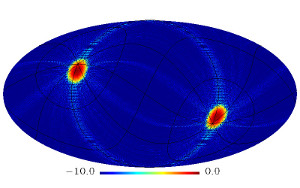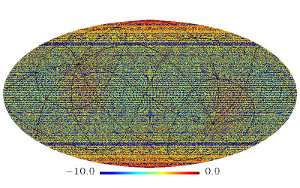|
|  |
At the beginning of the universe, just after its birth but before the
Big Bang when the universe became hot, our cosmos
expanded exponentially during a very short period called cosmic
inflation. This process is an indispensable building-block of the
standard model of the universe; however, we do not yet know which
physical mechanism caused this inflation.
The standard inflation scenario is described by a nearly de Sitter
space-time. In this framework, there are ten isometric
transformations, i.e. mappings that preserve distances: three spatial
translations; three spatial rotations; one time translation
accompanied by spatial dilation; and three additional isometries,
which reduce to special conformal transformations as time approaches
infinity.
As the expansion rate is necessarily time-dependent (because inflation
must end) this breaks the time translation symmetry and hence the
spatial dilation symmetry, limiting how much the universe deviates
from dilation invariance. In terms of observations, such dilation
invariance would give precisely scale-invariant initial fluctuations for
the early universe, whereas a small deviation has been detected from
CMB data by Planck with more than 5 sigma significance.
In the usual model of inflation, six of the ten isometries remain
unbroken: translations and rotations. But why must they remain
unbroken while the others are broken? In fact, slight deviations from
rotation symmetry naturally arise in "anisotropic inflation" models,
in which a scalar field is coupled to a vector field. A violation of
rotational symmetry also occurs when very long-wavelength
perturbations on super-horizon scales are coupled with
short-wavelength perturbation. Finally, a pre-inflationary universe
was probably very chaotic and highly anisotropic, and thus a remnant
of the pre-inflationary anisotropy may still be detectable. These
models lead to a quadrupolar modulation of the primordial two-point
correlation function, whose fractional strength is parametrized by
g*. When g* is different from zero, the strength of the two-point
correlation function depends on the angle between the line connecting
the two points and some preferred direction in space.
We tested the rotational symmetry by searching for such a preferred
direction using the two-point correlation function of primordial
perturbations. More precisely, we studied the CMB anisotropy, which is
linearly related to the primordial perturbations. For our analysis, we
used the CMB temperature data from the Planck mission released in
2013, which is publicly available at the Planck Legacy Archive. As the
main "CMB channel" we use the map at 143 GHz, because at this
frequency the contamination from synchrotron, free-free and dust
emission of our own galaxy is weaker than in other, higher frequency
channels. To further reduce the diffuse Galactic emission we fitted
templates to the 143 GHz map and subsequently removed them from the
observed maps. These foreground templates are created by subtracting
one frequency map from the map at an adjacent frequency - similar to
the "SEVEM"-method of the Planck collaboration.
From this preliminary analysis, we detect a significant quadrupolar
modulation of the CMB power spectrum (g* = -0.116 +/- 0.014 at 68%
confidence level) with a direction close to the Ecliptic pole. This is
shown in Figure 1a.
However, there is another effect which causes asymmetry. The Planck
beams at 143 GHz are not circular; the orientation of their semi-major
axes is parallel to Planck's scan direction, which lies approximately
along the Ecliptic longitudes. This means that the beams are
"fatter" along the Ecliptic longitudes, and thus the Planck
satellite measures less power along the Ecliptic north-south direction
than in the east-west direction. In the data, this yields a
quadrupolar power modulation (with g* < 0).
After quantifying and removing the effect of this beam asymmetry, the
rotation asymmetry in the CMB basically vanishes (g* = 0.002 +/- 0.016 at
68% confidence level).
In Figure 1b, we show the probable locations of a preferred direction
estimated with a correction for the beam asymmetry
and Figure 2 shows the likelihood of the fractional strength of the
quadrupole modulation, which peaks at zero, when the correction is
added.
In a final step we tested the effect of the Galactic foreground
emission on our estimate. When we use the raw 143 GHz map without
foreground cleaning, we find significant anisotropy both before and
after the beam asymmetry correction (g* = 0.305 and 0.295 +/- 0.015,
respectively). The direction in this case lies close to the Galactic
pole; the foreground reduction thus plays an important role in nulling
artificial anisotropy in the data.
In a nutshell: After removing the effects of Planck's asymmetric beams
and of the Galactic foreground emission, we find no evidence for any
rotational asymmetry in our early Universe, which would be predicted
by anisotropic inflation models. Our limit (less than 2%) provides the
most stringent test of rotational symmetry during inflation so far.
Jaiseung Kim and Eiichiro Komatsu
|




